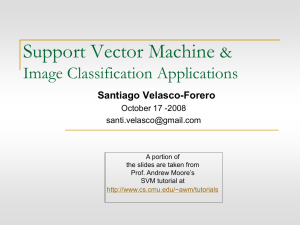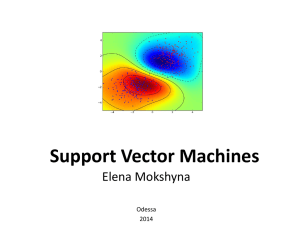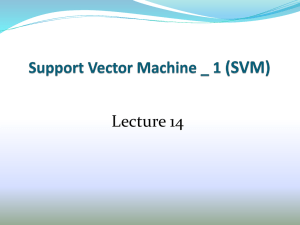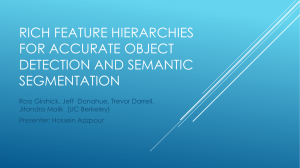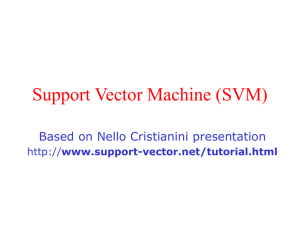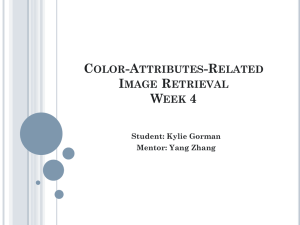Support Vector Machine and Its Applications
advertisement
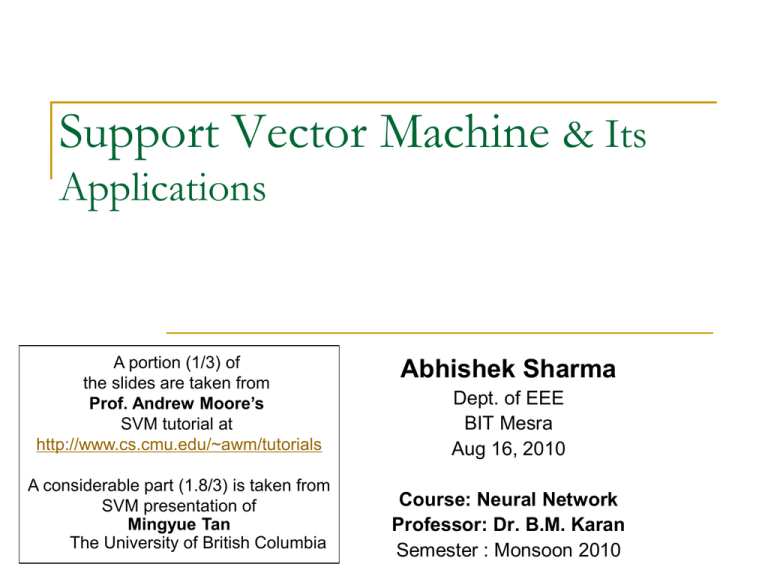
Support Vector Machine & Its
Applications
A portion (1/3) of
the slides are taken from
Prof. Andrew Moore’s
SVM tutorial at
http://www.cs.cmu.edu/~awm/tutorials
A considerable part (1.8/3) is taken from
SVM presentation of
Mingyue Tan
The University of British Columbia
Abhishek Sharma
Dept. of EEE
BIT Mesra
Aug 16, 2010
Course: Neural Network
Professor: Dr. B.M. Karan
Semester : Monsoon 2010
Overview
Artificial Neural Networks vs. SVM
Intro. to Support Vector Machines (SVM)
Properties of SVM
Applications
Text Categorization
References
ANN vs SVM
The development of ANNs followed a heuristic path, with
applications and extensive experimentation preceding theory.
In contrast, the development of SVMs involved sound theory first,
then implementation and experiments.
A significant advantage of SVMs is that whilst ANNs can suffer from
multiple local minima, the solution to an SVM is global and unique.
Two more advantages of SVMs are that that have a simple
geometric interpretation and give a sparse solution.
Unlike ANNs, the computational complexity of SVMs does not
depend on the dimensionality of the input space.
The reason that SVMs often outperform ANNs in practice is that
they deal with the biggest problem with ANNs, SVMs are less prone
to overfitting.
Researchers’ Opinions
"They differ radically from comparable approaches such
as neural networks: SVM training always finds a global
minimum, and their simple geometric interpretation
provides fertile ground for further investigation."
Burgess (1998)
"Unlike conventional statistical and neural network
methods, the SVM approach does not attempt to control
model complexity by keeping the number of features
small.
"In contrast to neural networks SVMs automatically
select their model size (by selecting the Support
vectors)."
Rychetsky (2001)
Support Vector Machine (SVM)
A classifier derived from statistical learning theory
by Vapnik, et al. in 1992
SVM became famous when, using images as
input, it gave accuracy comparable to neuralnetwork with hand-designed features in a
handwriting recognition task
Currently, SVM is widely used in object detection
& recognition, content-based image retrieval, text
recognition, biometrics, speech recognition, etc.
V. Vapnik
Linear Classifiers
x
denotes +1
w x + b>0
a
f
yest
f(x,w,b) = sign(w x + b)
denotes -1
How would you
classify this data?
w x + b<0
Linear Classifiers
x
denotes +1
a
f
yest
f(x,w,b) = sign(w x + b)
denotes -1
How would you
classify this data?
Linear Classifiers
x
denotes +1
a
f
yest
f(x,w,b) = sign(w x + b)
denotes -1
How would you
classify this data?
Linear Classifiers
x
denotes +1
a
f
yest
f(x,w,b) = sign(w x + b)
denotes -1
Any of these
would be fine..
..but which is
best?
a
Linear Classifiers
x
denotes +1
f
yest
f(x,w,b) = sign(w x + b)
denotes -1
How would you
classify this data?
Misclassified
to +1 class
Classifier Margin
x
denotes +1
denotes -1
a
f
yest
f(x,w,b) = sign(w x + b)
Define the margin
of a linear
classifier as the
width that the
boundary could be
increased by
before hitting a
datapoint.
Maximum Margin
a
x
denotes +1
denotes -1
Support Vectors
are those
datapoints that
the margin
pushes up
against
f
yest
1. Maximizing the margin is good
accordingf(x,w,b)
to intuition
and PAC
theory
= sign(w
x+
b)
2. Implies that only support vectors are
important; other The
training
examples
maximum
are ignorable.
margin linear
3. Empirically it works
very very
classifier
iswell.
the
linear classifier
with the, um,
maximum margin.
Linear SVM
This is the
simplest kind of
SVM (Called an
LSVM)
Let me digress to…what is PAC Theory?
Two important aspects of complexity in machine learning.
First, sample complexity: in many learning problems, training
data is expensive and we should hope not to need too much
of it.
Secondly, computational complexity: A neural network, for
example, which takes an hour to train may be of no practical
use in complex financial prediction problems.
Important that both the amount of training data required for a
prescribed level of performance and the running time of the
learning algorithm in learning from this data do not increase
too dramatically as the `difficulty' of the learning problem
increases.
Let me digress to…what is PAC Theory?
Such issues have been formalised and investigated
over the past decade within the field of
`computational learning theory'.
One popular framework for discussing such
problems is the probabilistic framework which has
become known as the `probably approximately
correct', or PAC, model of learning.
Linear SVM Mathematically
x+
M=Margin Width
X-
What we know:
w . x+ + b = +1
w . x- + b = -1
w . (x+-x-) = 2
(x x ) w 2
M
w
w
Linear SVM Mathematically
Goal: 1) Correctly classify all training data
wxi b 1 if yi = +1
wxi b 1 if yi = -1
yi (wxi b) 1 for all i 2
M
2) Maximize the Margin
1 t w
ww
same as minimize
2
We can formulate a Quadratic Optimization Problem and solve for w and b
1 t
Minimize ( w) 2 w w
subject to
yi (wxi b) 1
i
Solving the Optimization Problem
Find w and b such that
Φ(w) =½ wTw is minimized;
and for all {(xi ,yi)}: yi (wTxi + b) ≥ 1
Need to optimize a quadratic function subject to linear
constraints.
Quadratic optimization problems are a well-known class of
mathematical programming problems, and many (rather
intricate) algorithms exist for solving them.
The solution involves constructing a dual problem where a
Lagrange multiplier αi is associated with every constraint in the
primary problem:
Find α1…αN such that
Q(α) =Σαi - ½ΣΣαiαjyiyjxiTxj is maximized and
(1) Σαiyi = 0
(2) αi ≥ 0 for all αi
A digression… Lagrange Multipliers
In mathematical optimization, the method of Lagrange
multipliers provides a strategy for finding the maxima
and minima of a function subject to constraints.
For instance, consider the optimization problem
maximize
subject to
We introduce a new variable (λ) called a Lagrange
multiplier, and study the Lagrange function defined by
(the λ term may be either added or subtracted.)
If (x,y) is a maximum for the original constrained
problem, then there exists a λ such that (x,y,λ) is
a stationary point for the Lagrange function
(stationary points are those points where the partial
derivatives of Λ are zero).
The Optimization Problem Solution
The solution has the form:
w =Σαiyixi
b= yk- wTxk for any xk such that αk 0
Each non-zero αi indicates that corresponding xi is a
support vector.
Then the classifying function will have the form:
f(x) = ΣαiyixiTx + b
Notice that it relies on an inner product between the test
point x and the support vectors xi – we will return to this
later.
Also keep in mind that solving the optimization problem
involved computing the inner products xiTxj between all
pairs of training points.
Dataset with noise
denotes +1
Hard Margin: So far we require
all data points be classified correctly
denotes -1
- No training error
What if the training set is
noisy?
- Solution 1: use very powerful
kernels
OVERFITTING!
Soft Margin Classification
Slack variables ξi can be added to allow
misclassification of difficult or noisy examples.
e2
e11
What should our quadratic
optimization criterion be?
Minimize
R
e7
1
w.w C εk
2
k 1
Hard Margin v.s. Soft Margin
The old formulation:
Find w and b such that
Φ(w) =½ wTw is minimized and for all {(xi ,yi)}
yi (wTxi + b) ≥ 1
The new formulation incorporating slack variables:
Find w and b such that
Φ(w) =½ wTw + CΣξi is minimized and for all {(xi ,yi)}
yi (wTxi + b) ≥ 1- ξi and ξi ≥ 0 for all i
Parameter C can be viewed as a way to control
overfitting.
Linear SVMs: Overview
The classifier is a separating hyperplane.
Most “important” training points are support vectors; they
define the hyperplane.
Quadratic optimization algorithms can identify which training
points xi are support vectors with non-zero Lagrangian
multipliers αi.
Both in the dual formulation of the problem and in the solution
training points appear only inside dot products:
Find α1…αN such that
Q(α) =Σαi - ½ΣΣαiαjyiyjxiTxj is maximized and
(1) Σαiyi = 0
(2) 0 ≤ αi ≤ C for all αi
f(x) = ΣαiyixiTx + b
Non-linear SVMs
Datasets that are linearly separable with some noise
work out great:
x
0
But what are we going to do if the dataset is just too hard?
x
0
How about… mapping data to a higher-dimensional
space:
x2
0
x
Non-linear SVMs: Feature spaces
General idea: the original input space can always be
mapped to some higher-dimensional feature space
where the training set is separable:
Φ: x → φ(x)
The “Kernel Trick”
The linear classifier relies on dot product between vectors K(xi,xj)=xiTxj
If every data point is mapped into high-dimensional space via some
transformation Φ: x → φ(x), the dot product becomes:
K(xi,xj)= φ(xi) Tφ(xj)
A kernel function is some function that corresponds to an inner product in
some expanded feature space.
Example:
2-dimensional vectors x=[x1 x2]; let K(xi,xj)=(1 + xiTxj)2,
Need to show that K(xi,xj)= φ(xi) Tφ(xj):
K(xi,xj)=(1 + xiTxj)2,
= 1+ xi12xj12 + 2 xi1xj1 xi2xj2+ xi22xj22 + 2xi1xj1 + 2xi2xj2
= [1 xi12 √2 xi1xi2 xi22 √2xi1 √2xi2]T [1 xj12 √2 xj1xj2 xj22 √2xj1 √2xj2]
= φ(xi) Tφ(xj), where φ(x) = [1 x12 √2 x1x2 x22 √2x1 √2x2]
What Functions are Kernels?
For some functions K(xi,xj) checking that
K(xi,xj)= φ(xi) Tφ(xj) can be cumbersome.
Mercer’s theorem:
Every semi-positive definite symmetric function is a kernel
Examples of Kernel Functions
Linear: K(xi,xj)= xi Txj
Polynomial of power p: K(xi,xj)= (1+ xi Txj)p
Gaussian (radial-basis function network):
K (x i , x j ) exp(
xi x j
2
2
2
)
Sigmoid: K(xi,xj)= tanh(β0xi Txj + β1)
Non-linear SVMs Mathematically
Dual problem formulation:
Find α1…αN such that
Q(α) =Σαi - ½ΣΣαiαjyiyjK(xi, xj) is maximized and
(1) Σαiyi = 0
(2) αi ≥ 0 for all αi
The solution is:
f(x) = ΣαiyiK(xi, xj)+ b
Optimization techniques for finding αi’s remain the same!
Nonlinear SVM - Overview
SVM locates a separating hyperplane in the
feature space and classify points in that
space
It does not need to represent the space
explicitly, simply by defining a kernel
function
The kernel function plays the role of the dot
product in the feature space.
Properties of SVM
Flexibility in choosing a similarity function
Sparseness of solution when dealing with large data
sets
- only support vectors are used to specify the separating
hyperplane
Ability to handle large feature spaces
- complexity does not depend on the dimensionality of the
feature space
Overfitting can be controlled by soft margin
approach
Nice math property: a simple convex optimization problem
which is guaranteed to converge to a single global solution
Feature Selection
SVM Applications
SVM has been used successfully in many
real-world problems
- text (and hypertext) categorization
- image classification – different types of subproblems
- bioinformatics (Protein classification,
Cancer classification)
- hand-written character recognition
Weakness of SVM
It is sensitive to noise
- A relatively small number of mislabeled examples can
dramatically decrease the performance
It only considers two classes
- how to do multi-class classification with SVM?
- Answer:
1) with output arity m, learn m SVM’s
SVM 1 learns “Output==1” vs “Output != 1”
SVM 2 learns “Output==2” vs “Output != 2”
:
SVM m learns “Output==m” vs “Output != m”
2)To predict the output for a new input, just predict with each
SVM and find out which one puts the prediction the furthest
into the positive region.
Application: Text Categorization
Task: The classification of natural text (or
hypertext) documents into a fixed number of
predefined categories based on their content.
- email filtering, web searching, sorting documents by
topic, etc..
A document can be assigned to more than
one category, so this can be viewed as a
series of binary classification problems, one
for each category
Application : Face Expression
Recognition
Construct feature space, by use of
eigenvectors or other means
Multiple class problem, several expressions
Use multi-class SVM
Some Issues
Choice of kernel
- Gaussian or polynomial kernel is default
- if ineffective, more elaborate kernels are needed
Choice of kernel parameters
- e.g. σ in Gaussian kernel
- σ is the distance between closest points with different
classifications
- In the absence of reliable criteria, applications rely on the use
of a validation set or cross-validation to set such parameters.
Optimization criterion – Hard margin v.s. Soft margin
- a lengthy series of experiments in which various parameters
are tested
Additional Resources
LibSVM
An excellent tutorial on VC-dimension and Support
Vector Machines:
C.J.C. Burges. A tutorial on support vector machines for pattern
recognition. Data Mining and Knowledge Discovery, 2(2):955974, 1998.
The VC/SRM/SVM Bible:
Statistical Learning Theory by Vladimir Vapnik, WileyInterscience; 1998
http://www.kernel-machines.org/
Reference
Support Vector Machine Classification of
Microarray Gene Expression Data, Michael P. S.
Brown William Noble Grundy, David Lin, Nello
Cristianini, Charles Sugnet, Manuel Ares, Jr., David
Haussler
www.cs.utexas.edu/users/mooney/cs391L/svm.ppt
Text categorization with Support Vector
Machines:
learning with many relevant features
T. Joachims, ECML - 98

